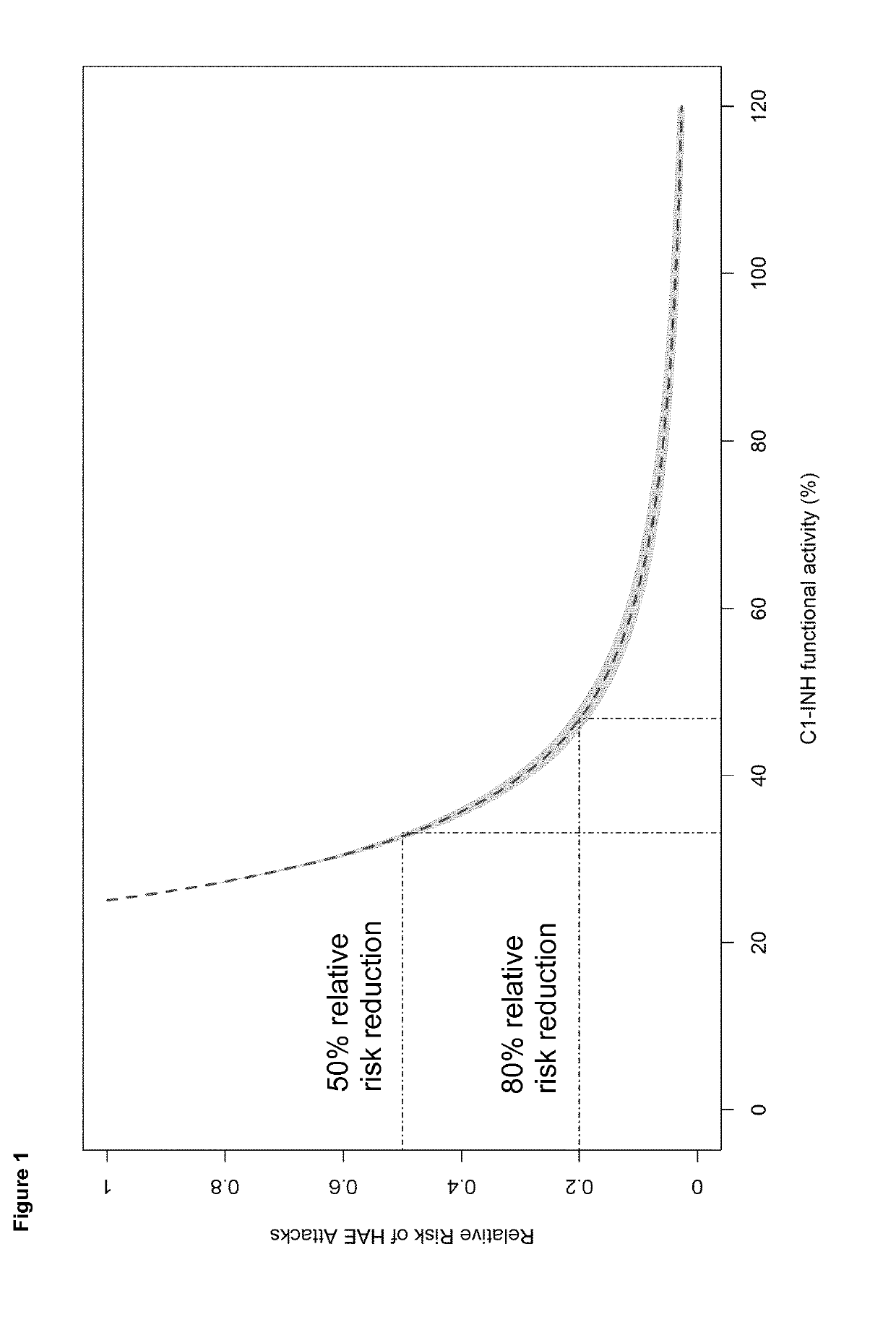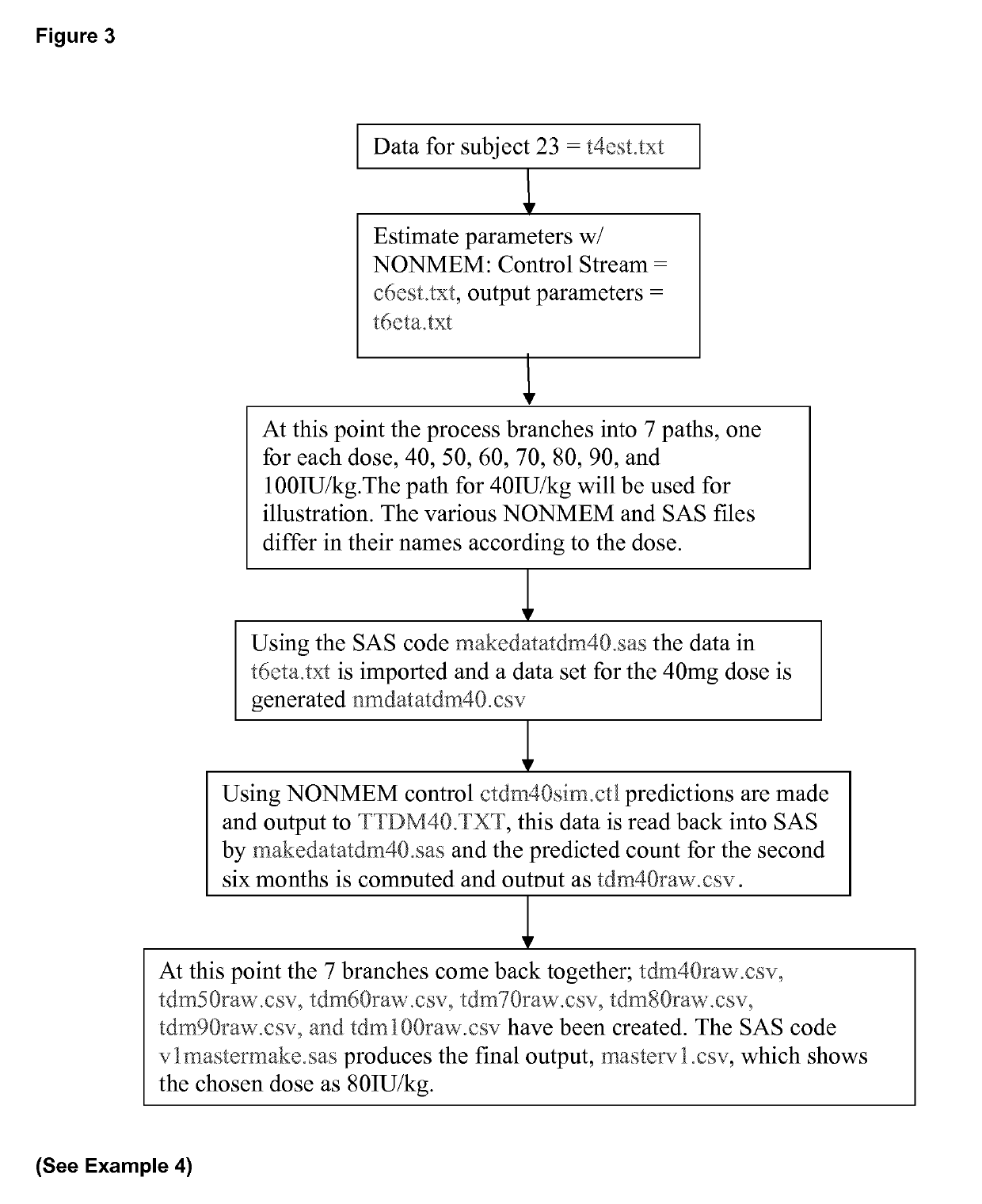Method of preventing acute attacks of hereditary angioedema associated with c1 esterase inhibitor deficiency
a technology hereditary angioedema, which is applied in the direction of instruments, extracellular fluid disorder, peptide/protein ingredients, etc., can solve the problems of high occurrence rate of breakthrough attacks, the need for repeated iv access, and the rapid decline of c1 esterase inhibitor functional activity levels, so as to improve the symptomatology, improve the treatment response, and reduce the risk of experiencing.
- Summary
- Abstract
- Description
- Claims
- Application Information
AI Technical Summary
Benefits of technology
Problems solved by technology
Method used
Image
Examples
example 1
[0172]To assess the relationship between C1-inhibitor functional activity and clinical response endpoints, a population-based pharmacokinetic-pharmacodynamic analysis was conducted using data from 90 patients who were randomized and treated (40 IU / kg vs Placebo or a 60 IU / kg vs Placebo treatment sequence; twice weekly, subcutaneous, self-administration). An interval censored repeated Time to Event (TTE) model was developed that allowed the ability to directly relate C1-INH functional activity at the time of attack to the HAE attack event. The final model consisted of two components: background (baseline) hazard and a drug effect in the form of a nonlinear maximum effect (Emax) function. Full model development included the addition of a random effect on the baseline hazard parameter (B0).
[0173]After development of the base model and addition of a random effect on B0, covariate testing was performed for the effect of age, weight, sex, baseline C1-inhibitor functional activity, baselin...
example 2
[0177]CSL830 is a high concentration, volume-reduced formulation of plasma-derived C1-INH for routine prophylaxis against HAE attacks by the SC route of administration. It is available as a sterile, lyophilized powder in a single-use vial containing 1,500 International Units (IU) for reconstitution with 3 mL of diluent (water for injection). Subcutaneous (SC) injection relative to IV infusion represents a potentially safer, more easily and practically administered at-home prophylactic treatment option for HAE patients whose disease warrants long-term C1-INH therapy. C1-INH when administered SC twice weekly is expected to provide stable steady-state plasma levels and overall higher trough plasma levels relative to IV administration.
[0178]Current dosing practice (standard of care or SOC) for CSL830 is SC administration of 60 IU / kg twice weekly. After approximately 6 months of treatment the dose may be reduced to 40 IU / kg if the event count in the previous 6 months was ≤6.
[0179]Therape...
example 3
[0209]
Table of Contents1LIST OF ABBREVIATIONS AND DEFINITIONS2SYNOPSIS3LIST OF TABLES4LIST OF FIGURES5LIST OF ATTACHMENTS6INTRODUCTION7OBJECTIVES8INVESTIGATIONAL PLAN8.1STUDY POPULATION, DOSE REGIMENS, AND PHARMACOKINETIC SAMPLING8.1.1Study 10018.1.2Study 20018.1.3Study 30018.2BIOANALYTICAL METHODS8.3DATA RETRIEVAL8.4DATA REVIEW8.5ANALYSIS POPULATION8.6PHARMACOK1NETIC ANALYSES METHODS8.7POPULATION PHARMACOKINETIC ANALYSIS8.7.1 Base Model8.7.2Covariate Modeling8.8MODEL EVALUATION AND DISCRIMINATION8.9FINAL MODEL EVALUATION8.9.1Visual Predictive Check8.9.2Bootstrap Analysis8.10SIMULATIONS8.10.1 Individual Predicted Pharmacokinetic Parameters9RESULTS9.1DATASET ANALYZED9.2DEMOGRAPHICS AND COVARIATES9.3BASE MODEL DEVELOPMENT9.4CO VARIATE MODEL DEVELOPMENT9.5FINAL MODEL9.6FINAL MODEL EVALUATION9.7POSTHOC ANALYSIS9.8SIMULATIONS9.9EXPLORATORY ANALYSIS9.9.1C1-INH Antigen9.9.2C4 Antigen9.9.3C1-INH Antigen vs. C4 Antigen10DISCUSSION11CONCLUSIONS12QUALITY CONTROL13REFERENCES14APPENDIX15ATTACHME...
PUM
| Property | Measurement | Unit |
|---|---|---|
| molecular weight | aaaaa | aaaaa |
| concentration | aaaaa | aaaaa |
| weight | aaaaa | aaaaa |
Abstract
Description
Claims
Application Information
 Login to View More
Login to View More - R&D
- Intellectual Property
- Life Sciences
- Materials
- Tech Scout
- Unparalleled Data Quality
- Higher Quality Content
- 60% Fewer Hallucinations
Browse by: Latest US Patents, China's latest patents, Technical Efficacy Thesaurus, Application Domain, Technology Topic, Popular Technical Reports.
© 2025 PatSnap. All rights reserved.Legal|Privacy policy|Modern Slavery Act Transparency Statement|Sitemap|About US| Contact US: help@patsnap.com



